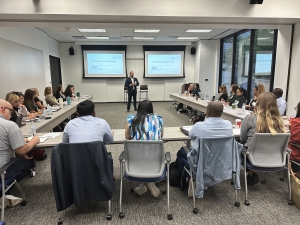Analysis by Energy Workforce SVP Government Affairs Tim Tarpley

At time of writing Wednesday, final control of both the House and Senate are still up in the air, but there are a few takeaways we can conclude at this point, especially about what it means for Energy Workforce issues and Member Companies for the next two years.
The first major takeaway is that Republicans had a bad night, significantly underperforming their own goals, as well as the traditional political expectations in a midterm election year with a President whose approval rating has been hovering in the low 40% range. Just a few weeks ago, expectations were high that Republicans would see a 40-50 seat majority in the House, and this is clearly not going to be the case.
As far as specific impacts, let’s begin with the House. As of now, Democrats have locked in 186 wins and Republicans 202. Control of the House requires 218 seats, so Republicans need to win at least 13 of the seats that are still in play. This is doable, but not guaranteed at this point. The important thing from the sector’s perspective is that if Republicans ultimately do prevail and take back the House, the margin is going to be razor thin. Looking at the outstanding races, it would be safe to assume that if Republicans are ultimately successful, the best guess on a margin would be somewhere in the 220-225 range at this point. That is razor thin.
With such tight margins, Rep. Kevin McCarthy (R-CA-23) will almost certainly face an internal challenge both from his right and left for the ultimate Speaker position. If he prevails in this challenge, which is far from a sure thing at this point, he will face a very difficult caucus to govern. With such tight margins, the minority wings of the caucus will wield tremendous power.
What does this mean for energy policy in such a House? Assuming McCarthy holds on and does become speaker, he will spend much of his time and political capital trying to hold on to that seat. While we still can expect investigations of the Biden Administration to remain front and center, there may be more of an internal struggle as to what the focus of these investigations should be.
We can expect the Freedom Caucus to wield more power and jockey for committee gavels in return for support. We can also expect appropriations battles to be more difficult with such small margins. Policies like the ESG SEC rule may be more likely to survive such a small-margin House. It will be difficult (especially if Senate does not flip) for a House with that makeup to successfully pushback on the rule using appropriations. Additionally, we may see environmental regulations such as the methane rule survive in such as a House as well. Democrats will only need to pick up a few votes in order to protect any particular provision on an appropriations package.
The Senate appears to be even closer and may be up in the air for some weeks. As of now, Republicans appear to control 49 Senate seats and Democrats 48. The big surprise was John Fetterman pulled off a big win in Pennsylvania. This race will ultimately be important to the final control of the Senate. On energy policy, we should note that Fetterman has expressed support for fracking and to a lesser extent LNG exports, so policy-wise we are not likely to see significant change on those issues from his Senate office.
Votes are still being counted in Nevada and Arizona, but it is beginning to look like Senate control could ultimately hinge on the outcome of the Georgia Senate race. Georgia law requires one candidate to receive 50% plus one to avoid a runoff and it looks very unlikely that either candidate will pull that off at this point. This means we will not know who controls the Senate until December 6, the date of the runoff in Georgia.
For our purposes, ultimate control will have less effect than the fact that it will be very slim margins. From a practical standpoint, either way most legislation will shut down in the Senate. We can expect very little to happen in the next two years. There may be a window for a bipartisan permitting reform package at some point but considerable compromise on both sides will likely be needed. We may also see some last-minute deals cut with Sen. Joe Manchin (D-WV) or others to try and jockey for ultimate power.
Finally, we must ask ourselves what are the results going to mean for President Biden and his energy policies? This it seems will be a mixed bag. If the President avoids a massive beating (like it appears he will), many of his advisors that have been pushing an aggressive anti-oil and gas set of policies may be emboldened. Polling indicated these policies were extremely unpopular and could lead to rout at the polls. If this rout is avoided, we may see a doubling down on some of these policies by the administration.
With electoral pain seemingly dulled, it will be up to the potential minority in the House to pushback and use their investigative tools as aggressively as they can in the next two years. We can expect a game of cat and mouse in that scenario, where executive agencies attempt to shield much of their actions in regulatory actions. From our perspective, watching all regulatory actions and working with House allies to pushback on overreach will become extremely important. Most of our battles over the next two years will be of a regulatory nature.
While votes are still being counted and final takeaways perhaps a few weeks away, the initial takeaway for our sector is mixed. We certainly didn’t see the strong pushback against the Administration that many had hoped for, however we also didn’t see a full-fledged bear hug of the Administration by the American public either. We look to be heading into two years of divided government, and sometimes that can be alright for industry. Legislation will slow down … and things may just get a bit more predictable for a while.
For additional analysis and details on the impact to the energy services and technology sector, join the Government Affairs Committee and experts from FTI Consulting, Rice University’s Baker Institute and Akin Gump on November 17 for a virtual briefing.
Tim Tarpley, SVP Government Affairs & Counsel, analyzes federal policy for the Energy Workforce & Technology Council. Click here to subscribe to the Energy Workforce newsletter, which highlights sector-specific issues, best practices, activities and more.




